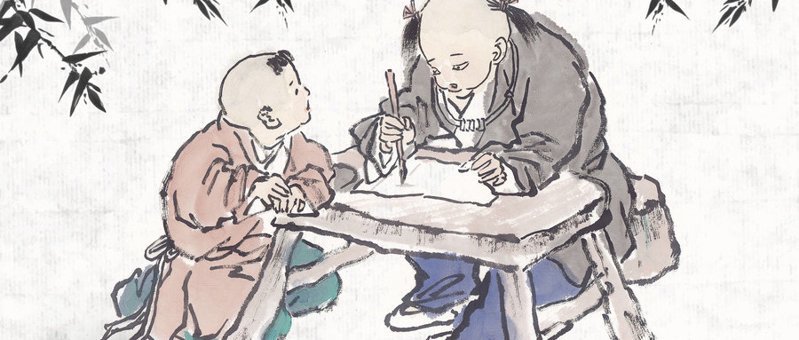Now let me talk about a few issues that you should pay attention to when practicing calligraphy:
The first issue is the choice of writing instrument. "If you want to do your job well, you must first get the tools." Whether it is a fountain pen or a ballpoint pen, you must choose a good pen that writes smoothly and has even line thickness. The ink is too light and difficult to identify; the ink is too dark and gives people a sense of depression. This often affects the mood of the marking teacher during the exam, causing unnecessary loss of points, so blue and black are the best ink colors for handwriting.

The second question: When practicing calligraphy, you should pay attention to the writing posture and the way to hold the pen. Since most middle school students now use ballpoint pens, I will use ballpoint pens as an example to talk about the writing posture and the method of holding the pen. When writing with a ballpoint pen, you must sit in a sitting position with your head upright, your body straight, your arms open, and your feet secure. Since ballpoint pens write small words, the movement of the pen tip should be in the area with the best visual effect. Generally, the right hand holds the pen, and the pen position should be slightly to the right. The eyes are about 30 cm from the paper, and the chest is about 10 cm from the edge of the table. Extend your arms naturally, with your forearms flat on the table. Press the left and right sides of the penholder with the pads of your thumb and index finger respectively. The left side of the first joint of the middle finger is against the bottom of the penholder. The ring finger and little finger are in turn close to the middle finger and naturally bent into a half-clenched fist shape, which serves as a municipal control function. The distance from the point of contact between the thumb and the pen barrel to the tip of the pen is about 4 cm. The penholder leans against the tiger's mouth, forming an angle of 45-60 degrees with the paper. The smaller the characters, the larger the angle. If you use a pen to write, you should also pay attention to the pen tip on the outside and the pen tongue on the inside, so that the middle seam of the pen tip touches the paper to ensure even water flow and smooth lines.
The third question: When practicing calligraphy, you need to be calm, start well and end well, and don't be impatient and perfunctory. When writing, you must be meticulous and every stroke must be written realistically. When some people practice calligraphy, they like to doodle before finishing. This kind of doodle is a taboo in calligraphy practice. It not only damages the life of the pen tip, but also makes the progress just made after practicing for a long time disappear.
The fourth question: Don’t change fonts easily. Practicing calligraphy requires perseverance, perseverance, and solid basic skills. You must practice calligraphy regularly, and you cannot be exposed to the cold for three days, fishing for three days, and drying the net for two days. Note: One day of practice will make you feel good, and one day of not practicing will make you empty. After mastering the font structure, you can choose the font you like and practice it persistently, and do not change fonts easily. Because once you change the font, you have to start from scratch.
The fifth question: We must learn to combine writing and practice. Some students write very well when practicing calligraphy, but they write randomly when doing homework. These students will never be able to practice calligraphy well. The calligraphy you have practiced should be used in daily life, and you should write as well as you practiced. Use each one you practice, learn by using it, use it while learning. Only by combining learning and application can you practice calligraphy well.
The sixth question: Teachers of all subjects must work together and cooperate closely. First of all, teachers should write standardized calligraphy, and secondly, they should encourage students to practice calligraphy. Students whose homework is sloppy should be criticized and educated so that they can correct it. Supervising students to practice calligraphy is not only the responsibility of Chinese teachers, but also every teacher.

5. There are three realms of calligraphy practice.
Everyone has read Jin Yong's novel "Swordsman", which contains an incisive discussion of sword training: When you first learn to practice, you use your hands to use the sword. Sometimes the sword does not obey the command, and you may even hurt yourself. After practicing for a period of time, the hand and sword become one, the sword is wielded with the heart, and the sword moves according to the heart, and the swordsmanship will reach a higher level. The highest level of swordsmanship is the unity of mind and sword, and there is no self without sword. Every move he makes is a sword, flying flowers and picking leaves are all sharp swords. A thin embroidery needle can withstand three swordsman masters. This kind of swordsmanship can be said to have reached a superb state.
The same is true for calligraphy practice. In the initial stage of calligraphy practice, we also use our hands to use the pen. There is a process from the pen not listening to the hand to becoming more and more proficient, and it can further develop to the state where the pen and hand become one. When I write at this time, I feel that the pen is part of my hand. I am not writing with a pen, but with my hand. As long as we practice seriously, we can achieve this state.
The second state of practicing calligraphy is to use the heart to make the pen, the heart and the pen are united, and the pen moves when the heart moves. What is written in the pen is what is in the heart. Once you reach this state, your calligraphy level can be said to be a small achievement. We all, including myself, must work hard to move toward this goal.
The third state of practicing calligraphy is to follow the teachings of nature, without self or pen. Many famous calligraphers in ancient times were like this. For example, Wang Xizhi saw the posture of the white goose swimming in the water, and realized the "floating goose hook" brushstrokes; Zhang Xu saw the bearers fighting for the way, and Gongsun Auntie dancing with the sword, and realized the give-and-take relationship of structural pointillism and the speed and rhythm of the brush. , which greatly enriched his cursive writing style; Huaisu watched Xia Yunhaitao and realized the majestic and overwhelming power of cursive script; Yan Zhenqing watched the leak marks in the house and painted sand with a cone, and understood the hesitation and strength of the brush. This is the ideal state for us to practice calligraphy. When we reach this state, we can write wonderful calligraphy works regardless of whether we have a pen or not, a soft pen or a hard pen, even a dead branch or a broken broom.








